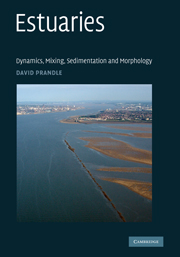Book contents
- Frontmatter
- Contents
- List of symbols
- 1 Introduction
- 2 Tidal dynamics
- 3 Currents
- 4 Saline intrusion
- 5 Sediment regimes
- 6 Synchronous estuaries: dynamics, saline intrusion and bathymetry
- 7 Synchronous estuaries: sediment trapping and sorting – stable morphology
- 8 Strategies for sustainability
- Index
- References
3 - Currents
Published online by Cambridge University Press: 01 September 2009
- Frontmatter
- Contents
- List of symbols
- 1 Introduction
- 2 Tidal dynamics
- 3 Currents
- 4 Saline intrusion
- 5 Sediment regimes
- 6 Synchronous estuaries: dynamics, saline intrusion and bathymetry
- 7 Synchronous estuaries: sediment trapping and sorting – stable morphology
- 8 Strategies for sustainability
- Index
- References
Summary
Introduction
The factors determining the magnitudes of depth-averaged tidal currents were described in Chapter 2. Here we explore the vertical structure of both tidal- and wind-driven currents. The structure of density-driven currents is described in Chapter 4. These structures are incorporated into subsequent theories relating to salinity intrusion, Chapter 4; sediment dynamics, Chapter 5 and morphological equilibrium, Chapters 6 and 7.
Models of tidal propagation involve numerical solutions to the momentum and continuity equations. In shelf seas, given adequate numerical resolution, the accuracy of simulations depends primarily on the specification of open-boundary conditions and water depths. Thus, the early 2D (vertically averaged) shelf-sea models (Heaps, 1969) paid scant attention to the specification of bed-stress coefficients. By contrast, applications in estuaries and bays often involve extensive calibration procedures requiring careful adjustment of bed friction coefficients (McDowell and Prandle, 1972). This predominant influence of frictional dissipation in shallow macro-tidal estuaries was illustrated in Chapter 2. In the more-recent 3D models, accurate specification of vertical eddy viscosity, E, is similarly essential to reproduce vertical current structure and related temperature and salinity distributions.
Validation of estuarine models of tidal propagation is often limited to comparisons against tide gauge recordings of water levels. In large estuaries with appreciable changes in phase and amplitude, accurate simulation of tidal elevations implies reasonable reproduction of depth-averaged currents (assuming accurate bathymetry).
- Type
- Chapter
- Information
- EstuariesDynamics, Mixing, Sedimentation and Morphology, pp. 50 - 77Publisher: Cambridge University PressPrint publication year: 2009



